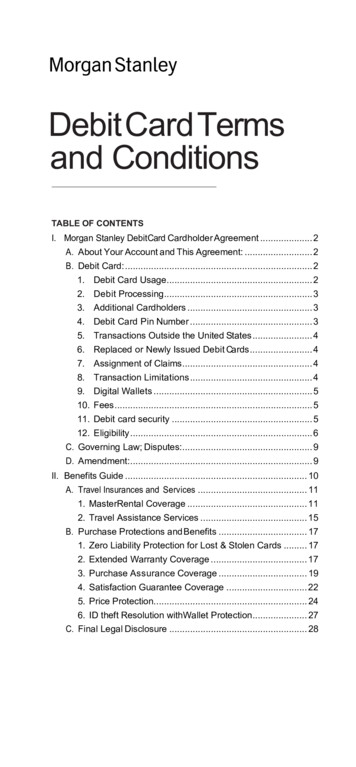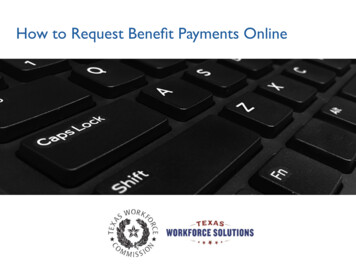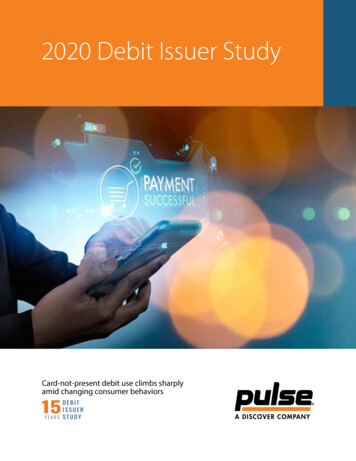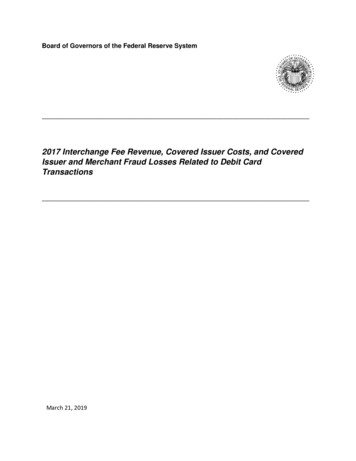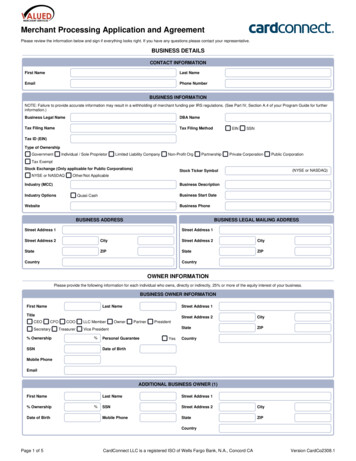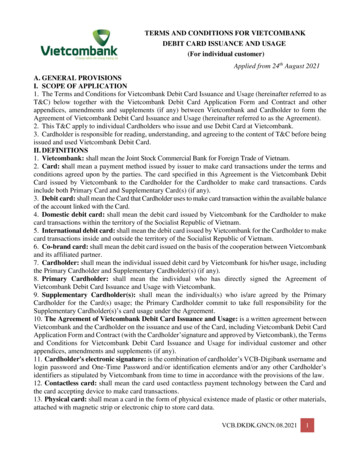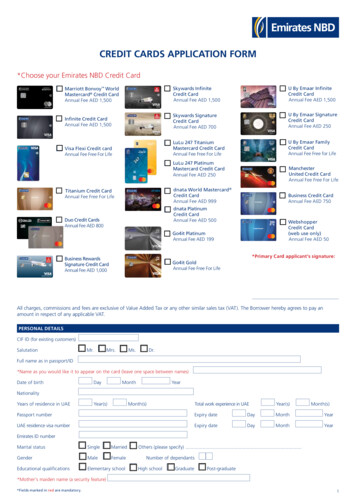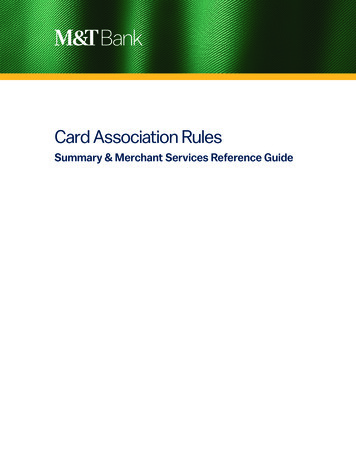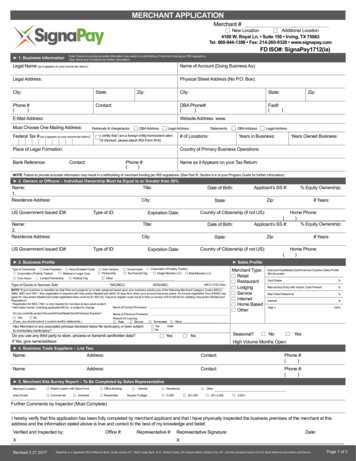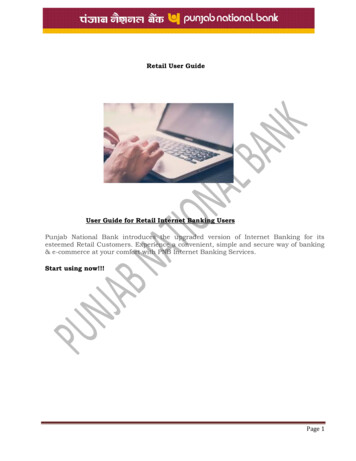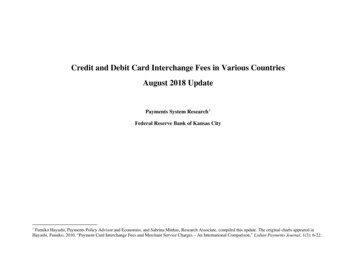
Transcription
Economic Quarterly— Volume 98, Number 3— Third Quarter 2012— Pages 159–183Debit Card Interchange FeeRegulation: Some Assessmentsand ConsiderationsZhu WangIn the summer of 2011, the Federal Reserve Board of Governorsissued a nal rule governing debit card interchange fees. This regulation, named Regulation II (Debit Card Interchange Fees andRouting), was required by the Durbin Amendment to the Dodd-FrankAct. The regulation, which went into e ect on October 1, 2011, limits the maximum permissible interchange fee that a covered issuer cancollect from merchants for a debit card transaction.The Durbin Amendment and the resulting regulation were createdto resolve the long-time con‡icts between card issuers and merchantsregarding payment card interchange fees. The interchange fee is theamount that a merchant has to pay the cardholder’s bank (the so-calledissuer) through the merchant acquiring bank (the so-called acquirer)when a card payment is processed. Merchants have criticized that cardnetworks (such as Visa and MasterCard) and their issuing banks haveused market power to set excessively high interchange fees, which driveup merchants’ costs of accepting card payments. Card networks andissuers disagree, countering that interchange fees have been properly setto serve the needs of all parties in the card system, including fundingbetter consumer reward programs that could also bene t merchants.By capping debit card interchange fees, the regulation has generated signi cant impact on the U.S. payments industry since its implementation. The most visible impact is the drop of multibillion-dollarI thank Kartik Athreya, Borys Grochulski, Sam Marshall, and Ned Prescott forhelpful comments, and John Muth for excellent research assistance. The views expressed herein are solely those of the author and do not necessarily re‡ect the viewsof the Federal Reserve Bank of Richmond or the Federal Reserve System. E-mail:zhu.wang@rich.frb.org.
160Federal Reserve Bank of Richmond Economic Quarterlyannual revenues for card issuers in terms of the interchange fees thatthey collect from merchants. Meanwhile, the regulation has yieldedother intended and unintended consequences. In this article, we reviewthe regulation’s impact from both positive and normative perspectives.We rst look into the empirical evidence of the regulation’s rst-yeare ects on di erent players in the debit card market, namely issuers,merchants, and consumers. We then provide a simple two-sided market model, based on the work of Rochet and Tirole (2011), to assessthe regulation’s implications on payments e ciency. The model shedslight on important policy questions, for example, whether the debitcard market performs ine ciently without regulation and whether theDurbin regulation can improve market outcome. Finally, we extendthe model to explain the regulation’s unintended consequence on smallticket merchants and discuss an alternative regulatory approach.The article is organized as follows. Section 1 provides the background of payment card markets and the interchange fee regulation.Section 2 reviews the empirical evidence on the regulation’s impact ondi erent players in the debit card market. Section 3 lays out a simplemodel of the payment card market and discusses the regulation’s implication on payments e ciency. We then extend the model to addressthe regulation’s unintended consequence on small-ticket merchants. Finally, Section 4 provides concluding remarks.1.INDUSTRY BACKGROUNDAs payments migrate from paper to electronic forms, credit and debitcards have become an increasingly important part of the U.S. paymentssystem. Recent data show that the payment share of credit and debitcards in personal consumption expenditures rose from 23 percent in1997 to 48 percent in 2011, while the share of cash and checks droppedfrom 70 percent to 35 percent (Figure 1).1 In 2011, debit cards wereused in 49 billion transactions for a total value of 1.8 trillion, andcredit cards were used in 26 billion transactions for a total value of 2.1 trillion.Along with this development has come controversy. Merchants arecritical of the fees that they pay to accept cards. These fees are oftenreferred to as the “merchant discounts,” which are composed mainlyof interchange fees paid by merchants to card issuing banks throughmerchant acquiring banks. Merchants believe that the card networks1The data are drawn from various issues of the Nilson Report. Payment shares notshown in Figure 1 include the automated clearing house and some other miscellaneoustypes.
Z. Wang: Debit Card Interchange Fee Regulation161Figure 1 Payment Shares of U.S. Personal ConsumptionExpenditures8060Share (Percent)Cash and 2002200320042005200620072008200920102011and issuing banks have wielded their market power to set excessivelyhigh interchange fees. The card networks and issuers counter thatthese interchange fees are necessary for covering issuers’ costs as wellas providing rewards to cardholders, which may also bene t merchantsby making consumers more willing to use the cards.Market OverviewTo understand the interchange fee controversy, some familiarity withthe payment card markets is helpful. Credit and debit cards are two ofthe most popular general-purpose payment cards in the United States.2Credit cards typically provide credit or ‡oat to cardholders, while debitcards directly draw from the cardholder’s bank account right after eachtransaction. Debit card payments are authorized either by the cardholder’s signature or by a personal identi cation number (PIN). The2Pre-paid cards are another type of general-purpose card, but their market size ismuch smaller compared with credit and debit cards. In 2011, the transaction value ofpre-paid cards accounted for 2 percent of U.S. personal consumption expenditures (Datasource: Nilson Report ).
162Federal Reserve Bank of Richmond Economic Quarterlyformer is called signature debit and the latter is called PIN debit. Interms of transaction volume, signature debit accounts for 60 percent ofdebit transactions, while PIN debit accounts for 40 percent.Visa and MasterCard are the two major credit card networks in theUnited States. They provide card services through member nancialinstitutions and account for 85 percent of the U.S. consumer credit cardmarket.3 Visa and MasterCard are also the primary providers of debitcard services. The two networks split the signature debit market, withVisa holding 75 percent of the market share and MasterCard holding25 percent.4 In contrast, PIN debit transactions are routed over thePIN debit networks. Currently, there are 14 PIN debit networks inthe United States. Interlink, Star, Pulse, and NYCE are the top fournetworks, together holding 90 percent of the PIN debit market. Thelargest PIN network, Interlink, is operated by Visa.Visa, MasterCard, and PIN debit networks are commonly referredto as four-party schemes because four parties are involved in each transaction in addition to the network whose brand appears on the card.These parties include: (1) the cardholder who makes the purchase; (2)the merchant who makes the sale and accepts the card payment; (3)the nancial institution that issues the card and makes the paymenton behalf of the cardholder (the so-called issuer); and (4) the nancialinstitution that collects the payment on behalf of the merchant (theso-called acquirer).In a four-party card scheme, interchange fees are collectively set bythe card network on behalf of their member issuers. For a simple example of how interchange functions, imagine a consumer making a 50purchase with a payment card. For that 50 item, the merchant wouldget approximately 49. The remaining 1, known as the merchant discount, gets divided up. About 0.80 would go to the card issuing bankas the interchange fee, and 0.20 would go to the merchant acquiring bank (the retailer’s account provider)
Figure 2 plots the interchange fee for a 50 non-supermarket trans-action for Visa and MasterCard credit cards, signature debit cards, as well as the top four PIN debit cards in the United States.6 As the -gure shows, credit and PIN debit interchange fees have been rising since the late 1990s, while signature debit interchange fees came down
